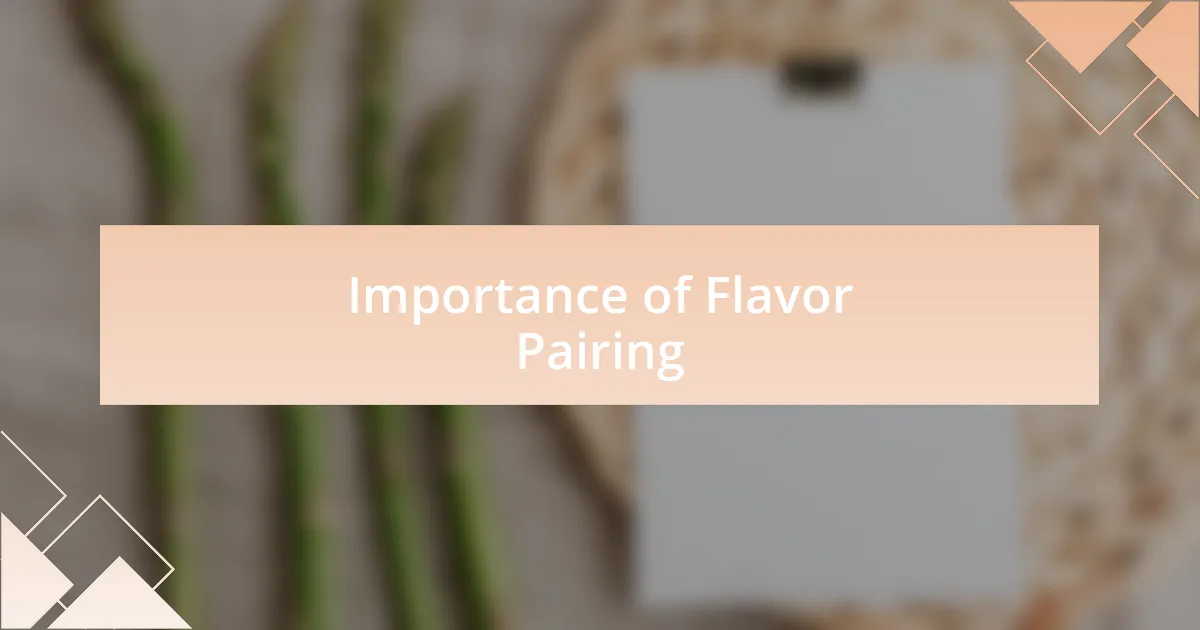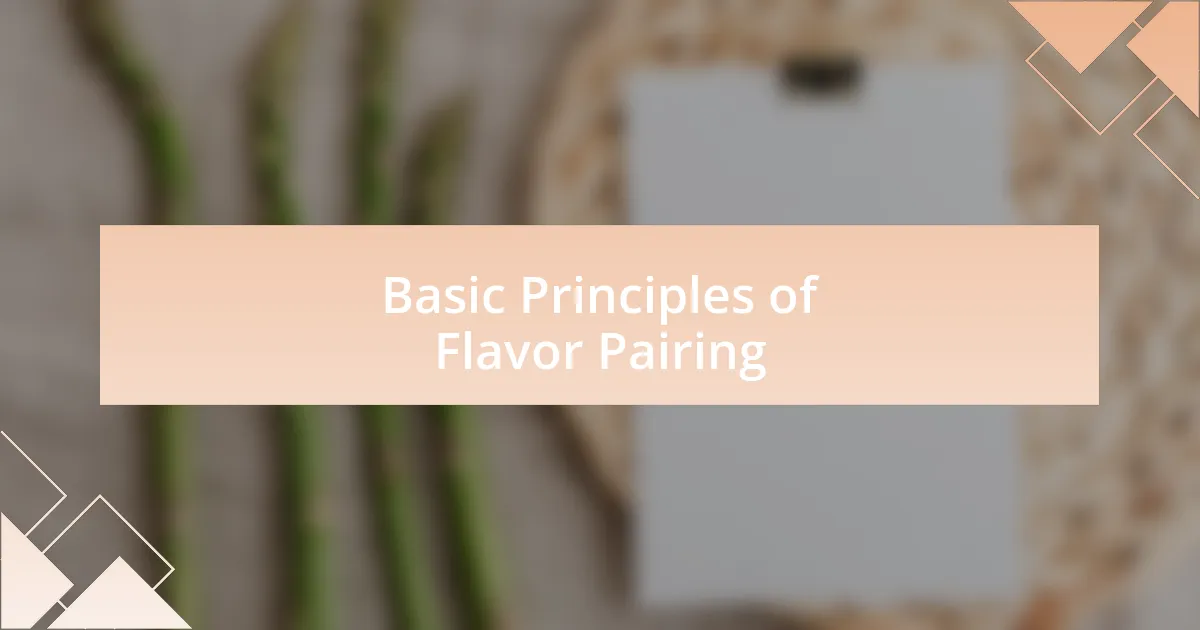Key takeaways:
- Flavor pairing enhances dishes by balancing complementary elements such as sweet, salty, spicy, and sour.
- Experimenting with unique combinations can lead to surprising and delightful culinary experiences.
- Seasonal ingredients and their peak freshness significantly enhance the overall flavor and emotional connection to dishes.
- Trusting one’s senses and being open to unexpected pairings can lead to memorable and innovative flavors.

Understanding Flavor Pairing
Understanding flavor pairing is like unlocking the secrets of culinary chemistry. I remember the first time I combined strawberries with balsamic vinegar. The tangy sweetness of the strawberries danced perfectly with the acidity of the vinegar, awakening my palate in ways I hadn’t anticipated. It made me realize how different ingredients can complement each other, creating a harmony that elevates a dish to new heights.
When I think about flavor pairing, I often refer to the concept of balance. Have you ever considered how spicy, sweet, sour, and salty can coexist in one bite? One of my favorite experiences was experimenting with chocolate and chili. The heat from the chili made the chocolate’s richness even more profound, my taste buds were racing! This balance is key to an unforgettable culinary adventure.
Delving deeper into flavor science, I learned that pairing is not just about things that taste good together; it’s also about aroma, texture, and even presentation. There’s a fascinating science behind why certain flavors work well together—think of the classic combo of lemon and garlic. It’s intriguing to explore how these connections can surprise us, leading to new discoveries in our kitchens. What have you found surprising about flavor combinations?

Importance of Flavor Pairing
Flavor pairing is crucial because it can transform a dish from mundane to extraordinary. I once tried a simple sweet potato mash with a sprinkle of cinnamon and a hint of orange zest. The warmth of the cinnamon combined with the citrusy brightness of the zest breathed new life into the dish, illustrating how even minor adjustments can significantly impact the overall flavor experience. Have you ever wondered how a small tweak could completely change your meal?
The importance of flavor pairing extends to enhancing each ingredient’s unique characteristics. For example, I began using fresh herbs like basil with tomatoes, and the resulting burst of freshness added complexity to familiar flavors. This revelation demonstrated that thoughtful combinations not only highlight the main ingredient but also create a delightful interplay of tastes on the palate.
Additionally, understanding flavor pairing fosters creativity in the kitchen. By experimenting with unusual combinations, such as pairing avocado with chocolate, I discovered an unexpected creaminess that made desserts feel indulgent yet healthy. This exploration encourages a mindset of curiosity, empowering us to challenge traditional culinary boundaries. What adventurous pairings have you tried that surprised you?

Basic Principles of Flavor Pairing
When it comes to the basic principles of flavor pairing, one essential concept is the idea of complementary flavors. I remember the first time I paired rich, hearty beef with the bright acidity of balsamic vinegar—it was a revelation. The sharpness of the vinegar cut through the savory meat, transforming the dish into something truly dynamic. Have you ever considered how a splash of acidity can elevate the flavors in your meal?
Another fundamental principle revolves around balancing flavors. Sweet and salty, spicy and cool—these contrasts can create a delightful harmony on the palate. For instance, I once made a salad with watermelon, feta cheese, and a sprinkle of chili flakes. The sweetness of the watermelon played beautifully against the salty feta, while the chili added just the right amount of heat. It’s fascinating how these opposing flavors work together to enhance the overall experience. Have you experimented with contrasting flavors in your cooking?
Lastly, seasonality plays a key role in effective flavor pairing. I find that using ingredients at their peak freshness not only boosts taste but also enhances the emotional connection to the dish. When I made a spring pasta with asparagus and lemon, the vibrant colors and flavors transported me to sunny days. It’s incredible how seasonal ingredients can inspire creativity and lead to unforgettable culinary experiences. What seasonal ingredients do you love incorporating into your meals?

Techniques for Pairing Flavors
Techniques for pairing flavors can be both intuitive and structured. I often rely on flavor wheels, which visually represent how flavors interact. For example, discovering that citrus pairs beautifully with herbs was a game changer for me. When I squeezed fresh lemon over a basil pesto pasta, the zesty brightness elevated the dish in a way I hadn’t expected. Have you ever used a flavor wheel to guide your culinary explorations?
Another effective method is to draw inspiration from global cuisines. Each culture has its unique flavor combinations that harmonize beautifully. It was during a trip to Thailand that I first tasted the magical interplay of coconut milk and lemongrass in curry. The creamy sweetness of the coconut balanced the aromatic freshness of the lemongrass, creating a dish I couldn’t forget. Exploring international flavor profiles has opened a vast world of possibilities for my cooking. What cuisines have surprisingly influenced your own dishes?
Lastly, trial and error can’t be overlooked in the flavor pairing process. Some of my greatest culinary breakthroughs came from simply experimenting in the kitchen. For instance, I once tried pairing dark chocolate with chili powder, and the result was an unexpected yet delightful kick. Embracing the adventurous spirit of cooking not only leads to delicious discoveries but also nurtures my passion for flavor exploration. What daring combinations have you tried that surprised you?

Personal Experiences with Flavor Pairing
One memorable flavor pairing journey for me was when I learned to combine sweet and savory elements in unexpected ways. I remember creating a dish with roasted butternut squash and feta cheese, then adding a drizzle of honey. The sweetness of the squash mingled with the tangy feta and the honey created a symphony of flavors that completely transformed my perspective on salads. Have you ever experimented with mixing tastes that felt risky yet turned out to be a hit?
Another experience that stands out was my first try at pairing miso and caramel. I was initially skeptical, thinking that the savory ferment might clash with the sweet. But after I blended miso into homemade caramel sauce and drizzled it over vanilla ice cream, I was floored by how the umami enhanced the sweetness, creating an entirely new depth of flavor. This revelation taught me that sometimes, it’s the flavors you least expect to work together that create the most memorable dishes. What unconventional pairings have you discovered that changed your culinary approach?
During a cooking class, I experimented with the classic combination of tomatoes and basil but took it a step further by adding fresh strawberries. The juicy, sweet strawberries complemented the acidity of the tomatoes in ways I had never anticipated. The flavors danced on my palate, and I felt inspired to push my boundaries even further in my culinary creations. How has experimenting with your flavor pairings inspired you to think outside the box?

Creating Unique Flavor Combinations
Creating unique flavor combinations often feels like a thrilling experiment, where the kitchen transforms into a lab for creativity. One time, I decided to try incorporating smoked paprika into a traditional chocolate brownie recipe. Initially, I was unsure about how this spice would mesh with the sweetness, but the smokiness added a layer of complexity that elevated the brownies to an unexpected level. Have you ever taken a risk in the kitchen that ended up being a delightful surprise?
I remember attending a food festival where I tasted a dish that paired lavender and lemon. At first, I thought, “Isn’t that too floral for a savory dish?” But as I took a bite, the herbal notes of lavender beautifully complemented the bright acidity of the lemon. It opened my eyes to the idea that flowers can do more than just look pretty—they can transform dishes into something ethereal. What are some flavors you’ve hesitated to use but later found to be enlightening?
Another unforgettable experience occurred when I created a vinaigrette using pineapple juice and ginger. Traditionally, these ingredients are often kept separate, yet together, they created a light, zesty dressing that awakened my salads in a way I never expected. It taught me that combining flavors from different culinary cultures can yield astonishing results. Have you discovered a pairing that seemed odd but felt right once you tried it?

Tips for Successful Flavor Pairing
When it comes to flavor pairing, I find that balancing contrasting elements can lead to some of the most exhilarating results. For instance, I once added a pinch of chili flakes to a creamy avocado dip. The heat from the chili didn’t just enhance the flavors, it created a vibrant tension that kept my taste buds engaged. Have you ever experienced that perfect dance of contrasting tastes on your palate?
I’ve also learned that searching for shared flavor profiles can be just as impactful. One of my favorite dishes showcases the harmony between figs and blue cheese. The sweetness of the figs draws out the creamy tang of the cheese, creating a marriage of flavors that feels utterly complete. Can you think of a couple of ingredients that complement each other so well that they elevate the entire dish?
Lastly, I always remind myself to trust my senses and intuition. One evening, I was experimenting with a pumpkin soup and decided to toss in some nutmeg and a splash of orange juice. It felt unconventional, yet the warming spices paired with the citrus brightened the entire dish. Have you ever followed your instincts in the kitchen, taking a leap of faith that turned out beautifully?